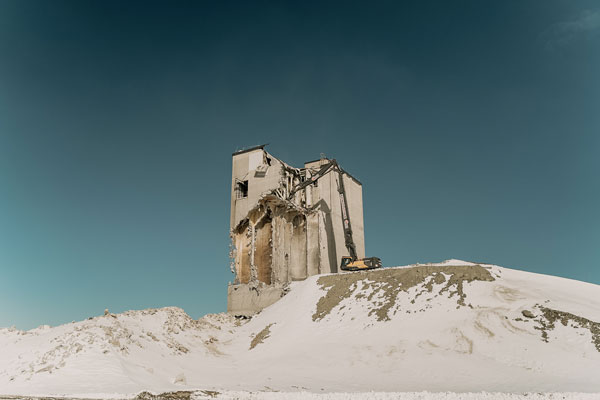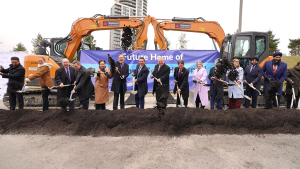It must have been quite a site for nearby residents to see a large, high concrete tower being toppled this past winter. The tower was the last remaining section of a former dog food manufacturing plant in southwest Mississauga.
Demolishing that plant might roughly be compared to a game of chess where the master player first eliminates all of the opponent’s pawns and then sets sights on the higher-level pieces.
In this particular project, the king and queens were a number of steel silos and concrete towers and at the south end of the sprawling plant.
The demolition began at the end of September 2021 and was completed near the end of March, says Dan Marinacci, principal, MGI Construction Corp., which is performing multiple roles as the demolition, earthworks, and civil works contractor.
Located on Royal Windsor Drive within view of Lake Ontario, the two-level 13,391-square-metre sprawling plant on Royal Windsor Drive was flattened to make way for CBRE’s Royal Windsor Drive Industrial Park, which will be comprised of two speculative industrial buildings. Traugott Building Contactors is the general contractor for the building portion of the project.

Hamilton-based Nassar Engineering collaborated with MGI’s internal engineering department on the demolition methodology plan. As is the case with most demolitions, it was comprised of three phases: the abatement process, the interior gutting, and then, the structural demolition. However, that third phase was divided into two.
“We needed to create room,” says Marinacci, explaining the main plant had to be flattened and cleared first before the silos and towers could be brought down. Those structures had been used for the storing of water, feed, and other and other materials necessary in the manufacturing process.
The gutting, structural demolition, and debris removal from the main plant took from about the end of September to the end of November. This phase of the project was fairly straight-forward, says Marinacci, who adds, “There were some challenges, but nothing we haven’t encountered before.”
Not so straight-forward was the demolition of the concrete towers, which, because of their industrial function, were reinforced with internal heavy duty steel tubes and comprised of a series of compartments, he says. “There weren’t clear spans.”
Adding to the complexity was that the two highest towers where well over 30 metres high, (100 feet) with the highest extending to approximately 60 metres (200 feet). Those distances were beyond the limits of high reach excavators operating from ground level.
“We had to build a ramp to grapple with the towers,” says Marinacci.
It took three to four weeks to build and compact that ramp which was comprised of 55,000 cubic metres of clean trucked to the site. A ‘plateau’ was graded at top for safe operation of the excavators which “eat away’’ at the towers to the point they were structurally weak enough to be knocked down, said Marinacci, who didn’t want to disclose too many technical details of how the procedure was carried out. The lower tower was demolished first, and then the higher tower.
An integral part of the project is the recycling initiatives now well underway. The fill used to erect the ramp is being graded around the site to provide the extra height the new industrial buildings require. Similarly, all the recovered concrete, asphalt, and brick will be incorporated into the new development, he says.
Although the demolition is basically wrapped up, MGI will remain on site until probably the fall in its role as the earth works and civil works contractor. In that role, it will be responsible for a host of duties including erecting retaining walls, excavating the foundations for the new buildings, and installing sewers and other site services, says Marinacci.











Recent Comments
comments for this post are closed